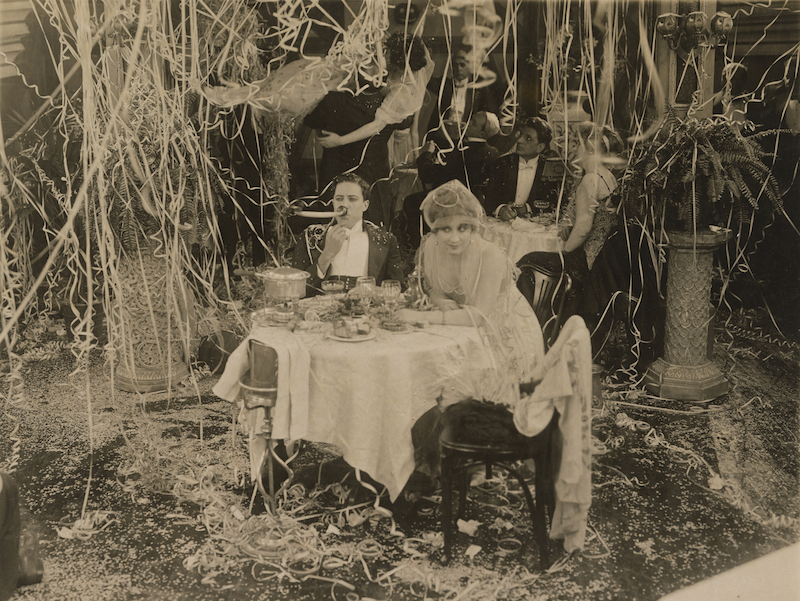A WIFE BY PROXY
John H. Collins (US 1917)
Metro Pictures was incorporated in March 1915 as both a production company and a distribution unit handling the output of subsidiary companies they controlled, which can make for some confusion in crediting the divisions involved. Conveniently, an article from The Daily Colonist (Victoria, B.C.), 15 October 1916 entitled “How Metro Markets its Motion Pictures” (available online) clarifies the division of labor. By June 1917 Metro took over their subsidiaries entirely, but for approximately two years they released features under the rubric of Rolfe Photo Plays, Popular Plays and Players, Quality Pictures Corporation, and Columbia Pictures Corporation (no relation to the later Columbia studio). John H. Collins, on long-term contract with Metro as of May 1916, was placed in the Columbia division, where he made features with his wife Viola Dana.
A Wife by Proxy is the only film Collins directed for Metro without Dana, probably because he was never meant to direct it at all. Star Mabel Taliaferro had been exclusively directed by Edwin Carewe since she joined the Metro fold in 1916, but as per Motion Picture News, Carewe needed surgery and was replaced by Collins, just back with Metro following his brief return to Edison to direct The Cossack Whip. Pre-release mentions of the film, provisionally titled “Jerry of the Emerald Isle,” credit Carewe with the story, sometimes in collaboration with John B. Clymer, and June Mathis with the scenario. At present it’s impossible to know whether Carewe really had a hand in the storyline; the print and subsequent publicity credit Clymer and Charles A. Logue with the story and Mathis with the scenario.
The film opens in Ireland, as a dying Patrick McNairne tells his daughter Jerry to go to New York and look up Norton Burbeck, a wealthy young man whose life Patrick had saved some time earlier (the surviving print, largely complete, lacks the second page insert of a letter explaining the full background). The affable Burbeck is due to inherit his uncle’s fortune provided he’s married by November; if not, the inheritance will go to his cousin Howard Curtis. An adventuress, Beatrice Gaden, and her husband Dick are in cahoots with Curtis: Beatrice pretends to be single in order to string Norton along up to the November date, at which time Curtis will come into the money and give a share to his unscrupulous partners. Meanwhile, Jerry has arrived and is taken into Burbeck’s home as a servant. Once the Gadens think it’s too late for Burbeck to marry anyone else, Beatrice reveals she has a husband, claiming he’s a beast. Ever generous, Norton tells her he’ll help arrange a divorce, but meanwhile his attorney Preston Cuyler advises him to immediately marry any female acquaintance in order not to lose the inheritance. Burbeck can’t bring himself to wed his homely housekeeper Martha Scraggs, so Jerry becomes the obvious choice.
As was so often the case with the plots of Collins’ films, A Wife by Proxy is composed of standard-issue narrative devices that even critics of the time derided: dying father, nefarious plotters out for an inheritance, amoral cosmopolitan woman vs. honest country lass. Yet as always with Collins’ films, it’s what he does with the material and his actors that transform tired stories into emotionally persuasive cinema. Ever attuned to atmosphere, whether the dark peasant cottage at the start or a Halloween ball, he frames his spaces to ensure clarity and psychological insight. As we’ve come to expect thanks to the two Collins programs recently presented at the Giornate, his masterful use of close-ups heightens our understanding of the characters’ personalities and conflicts – a close-up of Taliaferro’s face in Reel 2 feels like an early version of the famed shot of Viola Dana’s eyes in Blue Jeans. The last scene, shot on board the RMS Carpathia as it steams out of New York Harbor, offers a deeply satisfying finale in which glimpses of Ellis Island and the Statue of Liberty subtly underline the promise of America for immigrants exactly like Jerry.
Though largely forgotten today, large-eyed, expressive Mabel Taliaferro (1887-1979) was a major theatre star whose career began as Baby Bascom in the first Chicago production of Blue Jeans, before she was quite three years old. She’s well paired here with Sally Crute (1886-1971), an instinctual actress often used by Collins, including in The Cossack Whip and Blue Jeans. Robert Walker’s “manly beauty,” as declared in an intertitle, also graced a number of the director’s features. After Collins’ untimely death, Taliaferro remained close with Dana, as attested by several photographs of them together in the mid-1920s.
Jay Weissberg


regia/dir: John H. Collins.
sogg/story: John B[lanchard] Clymer, Charles A. Logue.
scen: June Mathis.
photog: A[rthur] A. Cadwell.
asst. dir: Albert Kelly [non accreditato/uncredited].
cast: Mabel Taliaferro (Jerry McNairne), Robert Walker (Norton Burbeck), Sally Crute (Beatrice Gaden), Fred C. Jones (Dick Gaden), Yale Benner (Howard Curtis), George Melville (Patrick McNairne), Ricca Allen (Martha Scraggs), Jerome Wilson (Preston Cuyler), Ed Mack (Flynn, il maggiordomo/the butler).
prod: Columbia Pictures Corporation.
dist: Metro Pictures Corporation.
uscita/rel: 06.01.1917.
copia/copy: 35mm, 4343 ft. (orig. c. 5000 ft.), 64′ (18 fps); did./titles: ENG.
fonte/source: Library of Congress Packard Campus for Audio Visual Conservation, Culpeper, VA.
Preservazione/Preserved by the Library of Congress in collaborazione con/in cooperation with Warner Bros.




